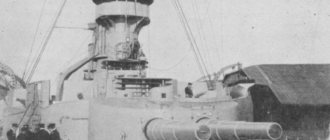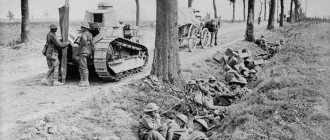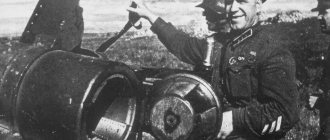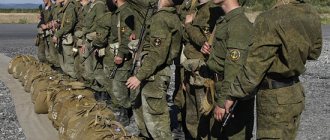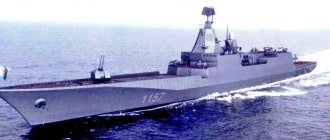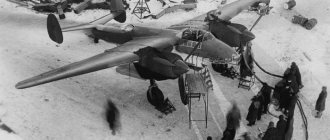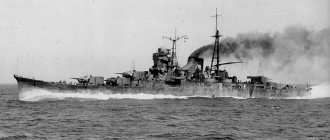Battle of Chesma
Major naval battles have been known in Russian history since the era of Peter the Great. The Emperor played a vital role in the creation of the navy. One of the largest battles of the eighteenth century took place during the Russo-Turkish War. The victory in this battle was so impressive that since 1770, July 7 has been celebrated as a day of military glory.
Let's take a closer look at what happened in Chesme Bay from July 5 to July 7, 1770.
Two squadrons were sent to the Black Sea from the Baltic, which merged into one on the spot. Command of the new fleet was entrusted to Count Alexei, brother of Grigory Orlov, a favorite of Catherine II.
The squadron consisted of thirteen capital ships (nine battleships, one bombardier and three frigates), as well as nineteen small support ships. In total, they had about six and a half thousand crew members.
During the transition, part of the Turkish fleet was discovered standing in the roadstead. Among the ships there were quite large vessels. For example, the Burj u Zafer had eighty-four guns on board, while the Rhodes had sixty. In total, there were seventy-three ships (of which sixteen were battleships and six frigates) and more than fifteen thousand sailors.
With the help of the skillful actions of Russian sailors, Alexei Orlov's squadron managed to win. Among the trophies was the Turkish Rhodes. The Turks lost more than eleven thousand people killed, and the Russians lost about seven hundred sailors.
Landing in Normandy
The Normandy offensive, which opened a “second front” against Nazi Germany in Europe, became the largest amphibious operation in world history. Anglo-American troops used 11.6 thousand aircraft and about 7 thousand small and large ships to land in France.
From sea to shore, with complete air supremacy of allied aviation, on June 6, 1944, 156 thousand soldiers and officers were simultaneously landed and seized bridgeheads for a further offensive.
Normandy offensive
In addition, 24 thousand British and American paratroopers were dropped in Normandy. Despite the high percentage of losses among them (missing, captured), they also played a big role in the success of the Battle of Normandy.
The Wehrmacht and Waffen SS defenses were broken through. Thanks to this, the Anglo-American offensive in France began to develop successfully.
Second Battle of Rochensalm
Sea battles in the eighteenth century were not always victorious. This is explained by the deplorable state of the fleet. After all, after the death of Emperor Peter I, no one cared about him properly.
Twenty years after the stunning victory over the Turks, the Russian fleet suffered a stunning defeat from the Swedes.
In 1790, the Swedish and Russian fleets met near the Finnish town of Kotka (formerly called Rochensalm). The first was commanded personally by King Gustav III, and the admiral in the last was the Frenchman Nissau-Singen.
176 Swedish ships with 12,500 crew and 145 Russian ships with 18,500 sailors met in the Gulf of Finland.
Hasty actions on the part of the young Frenchman led to a crushing defeat. The Russians lost more than 7,500 men, in contrast to 300 Swedish sailors.
Scientists say that this is the second battle with the largest number of ships in modern and recent history. We will talk about the grandest battle at the end of the article.
Operation Bagration
The Red Army's strategic offensive operation to liberate Belarus became the largest defeat of the German armed forces in its entire military history. Between June 23 and August 29, 1944, Soviet troops dealt a crushing blow to Hitler's Army Group Center.
Soviet troops, Operation Bagration
On the Soviet side, 1.67 million soldiers took part in the battles, on the German side - 1.2 million. In terms of its scope, Operation Bagration is included in the list of the main battles of the Second World War and throughout world history. German troops lost over 250 thousand people killed, over 158 thousand captured.
Tsushima
The cause of defeats was often various shortcomings and excessive zeal. For example, if we talk about the Battle of Tsushima, it occurred precisely when the Japanese fleet had an advantage in all respects.
The Russian sailors were extremely tired after a months-long journey from the Baltic to the Pacific Ocean. And the ships were inferior to the Japanese in fire power, armor and speed.
As a result of the admiral's rash act, the Russian Empire lost its fleet and any significance in this region. In exchange for a hundred wounded Japanese and three sunk destroyers, the Russians lost more than five thousand people killed, and more than six thousand were captured. In addition, out of thirty-eight ships, nineteen were sunk.
Tragedy in the Black Sea
At dawn on February 24, 1942, the Bulgarian ship Struma, drifting in quarantine off the Turkish coast, was rocked by a powerful explosion.
The ship broke in half and sank three minutes later, leaving only one survivor on the surface of the water - David Stolyar, who was able to swim to the shore. The most likely version of the ship's death is an attack by the Soviet submarine Shch-213, which was patrolling in the area. On February 20, a Soviet submarine sank the Turkish transport Cankaya in the same area. On February 24, submarine commander Lieutenant Commander D.M. Denezhko reported on the attack and sinking of “a large Bulgarian transport, with a displacement of 7,000 tons, coming from the bay at a speed of three knots.” Taking into account the fact that in this area at the indicated time there were no more deaths of any vessels or ships, most likely the Soviet boat attacked the ill-fated Struma. This is how one of the worst tragedies of the war on the Black Sea occurred: on board the Bulgarian ship there were 759 Jewish refugees from Romania, most of them women and children. As Romania increasingly strengthened its ties to Nazi Germany, the position of the Jewish population there became increasingly threatened. The Jewish community, donating money, chartered a dilapidated Bulgarian ship to sail to Palestine, which was then still under the British mandate. The Struma reached Turkey, but the Turks refused to allow the ship to pass through the straits without the consent of any of the states to accept refugees.
British Foreign Secretary Sir Anthony Eden said that issuing entry visas to the Jewish passengers of the Struma could set an unwanted precedent and, in their wake, thousands of other Jews would flood into Palestine. Harold McMichael, the Palestinian High Commissioner, and Walter Guinness, the Secretary of State for the Middle East, were strongly opposed to accepting the Struma's passengers. While waiting for a decision from the English authorities, the ship drifted along the Turkish coast, people lacked food and water, and illness began. The Turkish authorities, fearing an epidemic, did not allow passengers to disembark.
To be fair, the Jews clearly understood who was really to blame for the death of their compatriots. On November 6, 1944, Walter Guinness was killed by a Jewish militant from the LEHI organization - it was an act of revenge for the tragedy in the Black Sea.
Battle of Jutland
The Naval Battle of Jutland is considered the largest naval battle of the First World War. During the battle, 149 British and 99 German ships fought. In addition, several airships were used.
But the beauty of the events did not lie in the enormous displacement of the equipment or the number of wounded and killed. Not even in the consequences of the battle. The main feature that only the Jutland naval battle can boast of was surprise.
Both fleets accidentally collided in the Skagerrak Strait, near the Jutland Peninsula. Due to an intelligence error, the British walked very slowly and slowly towards Norway. The Germans were moving in the opposite direction.
The meeting turned out to be completely unexpected. When the English cruiser "Galatea" decided to inspect a Danish ship that accidentally found itself in these waters, a German ship was just leaving the "At the Fjord", which had already inspected it.
The British opened fire on the enemy. Then the rest of the ships arrived. The Battle of Jutland resulted in a tactical victory for the Germans, but a strategic defeat for Germany.
Battle of El Alamein
One of the largest battles of World War II took place in the North African theater of operations. More than 115 thousand soldiers and officers of Germany and Italy took part in it, who were opposed by over 220 thousand British soldiers.
Battle of El Alamein
During the first stage of the battle, during July 1942, the British were able to stop the enemy's rapid advance into Egypt and stabilize the front near the city of El Alamein. During the second and decisive stage of the battle, at the end of October - beginning of November 1942, British troops went on the offensive, defeated the enemy and forced him to retreat all the way to Tunisia.
This battle of World War 2 is considered by the British to be one of the most glorious and significant victories in British military history.
Pearl Harbor
When listing the naval battles of World War II, we should especially focus on the battle near Pearl Harbor. The Americans called it the “Attack on Pearl Harbor,” and the Japanese called it Operation Hawaiian.
The goal of this campaign was to proactively gain superiority in the Pacific region. The United States expected to enter into a war with the Empire of the Rising Sun, so military bases were created in the Philippines.
The mistake of the American government was that they did not seriously consider Pearl Harbor as a target for the Japanese. They expected an attack on Manila and the troops based there.
The Japanese wanted to destroy the enemy fleet and, with the help of this, simultaneously conquer airspace over the Pacific Ocean.
Only chance saved the Americans. The new aircraft carriers were in a different location during the attack. About three hundred aircraft and only eight old battleships were damaged.
Thus, the successful Japanese operation played a cruel joke in the future for this country. We will talk about her crushing defeat further.
First naval battle of World War II
Admiral Graf Spee became the third German “pocket battleship” built after the cruisers Deutschland (Lützow) and Admiral Scheer.
In the early months of World War II, she sank British merchant ships with impunity, becoming the most famous ship of her type. And the results of his first and last battle provide rich material for analyzing the effectiveness of artillery weapons and armor protection of German heavy cruisers. Why is the Battle of La Plata and its results still causing such heated debate?
At the outbreak of World War II, the heavy cruiser Admiral Graf Spee, under the command of Captain Zur See Hans Langsdorff, was in the Central Atlantic. He received the order to open the cruising war only on September 25, 1939 - until that moment, Hitler still hoped to peacefully resolve the conflict with Great Britain. The war was to be fought strictly according to prize rules, so there was no question of unexpected artillery or torpedo attacks.
For almost two and a half months, the Spee and the Deutschland, together with several supply ships, operated with impunity in the Atlantic and Indian Oceans. To search for them, the British and French had to allocate 3 battle cruisers, 3 aircraft carriers, 9 heavy and 5 light cruisers. Eventually, Commodore Henry Harewood's Group G (heavy cruiser Exeter, light cruisers Ajax and Achilles) intercepted the Spee off the coast of South America, near the mouth of the La Plata River.
This battle became one of the few classic artillery naval battles of World War II, providing a clear illustration of the old debate about what is more effective - the caliber of the guns or the weight of the salvo?
"Admiral Graf Spee" passes through the Kiel Canal, 1939 Source - johannes-heyen.de
In terms of total displacement, the three British cruisers were approximately twice as large as the Spee, and more than one and a half times greater in weight per minute salvo. To extol the achievements of their side, some British researchers compared the weight of a single salvo of ships without taking into account the rate of fire - these figures reached the Soviet press and for some time disoriented lovers of naval history. According to these data, a ship with a standard displacement of 12,540 tons was twice as powerful as three cruisers with a total standard displacement of 22,400 tons.
Diagram of the heavy cruiser "Admiral Graf Spee", 1939 Source - A. V. Platonov, Yu. V. Apalkov. German warships, 1939–1945. St. Petersburg, 1995
“Spee” carried only six guns, but 283-mm caliber, firing 4,500 kg of metal per minute. In addition, it had eight 150-mm guns in light mounts, placed four per side (another 2,540 kg of metal per minute, 1,270 kg per side).
Aft tower of “Admiral Count Spee” Source – commons.wikimedia.org
The Exeter also carried six guns, but only 203 mm, as it was originally considered a B-class scout rather than an A-class. The weight of its one-minute salvo was only 2780 kg - more than two times less than that of the enemy. The same type "Ajax" (Harewood's flag) and "Achilles" each had eight 152-mm guns in two-gun turrets and at the maximum rate of fire (8 rounds per minute) could fire 3,260 kg of metal per minute (more than the flagship). Thus, the total broadside salvo of the British squadron was 9300 kg, that is, it exceeded the salvo of the Spee, if not two, then at least one and a half times (taking into account the fact that the average caliber of the “German” could fire on board only half of the guns) . Undoubtedly, the Spee was much better protected, but had a speed of 5 knots less. Thus, there was a classic example of an “asymmetrical” battle in which each side had its own advantages.
One against three
The opponents discovered each other on the morning of December 13, 1939, almost simultaneously (about 5:50 GMT), but the Germans quickly realized that in front of them were warships. True, they mistook the light cruisers for destroyers, so the raider willingly moved to approach. In the first minutes, no one opened fire, although the distance was a little more than a hundred cables.
At 6:14, Commodore Harewood gave the order to split up to capture the enemy in a pincer movement. The heavy Exeter moved straight towards the German, passing to his left, while both light cruisers moved in a wide arc, bypassing the enemy on the right and keeping a great distance from him. This maneuver looks strange: keeping a distance of a hundred cables, the British had little chance of hitting the enemy, while the enemy 283-mm cannons remained very dangerous for them. On the contrary, the most effective tactic for them was to quickly close the distance and approach to such a distance that 152-mm shells could penetrate the side of the Spee. In addition, this would allow the British to use torpedo tubes - the Germans were afraid of such a possibility (evidence of this is the behavior of “Luttsov” and “Hipper” in the “New Year’s Battle” on December 31, 1942). Exeter actually fired torpedoes at the beginning of the battle, but Ajax used them only at the end of the battle (about 7:30), when the distance was reduced to 50 cabs; a little earlier, Spee fired one torpedo. Even if the torpedoes had not hit the German cruiser, dodging them would, one way or another, reduce the accuracy of its shooting.
English cruisers Ajax and Exeter (in the background). Montevideo, November 1939 Source - V. Kofman, M. Knyazev. Hitler's armored pirates. Heavy cruisers of the Deutschland and Admiral Hipper classes. M.: Yauza, Eksmo, 2012
In turn, Exeter, with its longer-range guns, had no need to reduce the distance. The only explanation for his maneuver is that the British exaggerated the defense of the Admiral Graf Spee and tried to get closer to him. However, this in no way justifies the division of forces: alone, the heavy cruiser was significantly inferior to the “pocket battleship”. In addition, by approaching from different directions, the British allowed the enemy to bring into action all eight 150-mm guns instead of four.
First phase of the battle: a crushing blow to Exeter
At 6:18, the Spee opened fire on the Exeter from the main caliber bow turret from a distance of approximately 90 kb. Exeter responded at 6:20 - first from two bow turrets, then, turning slightly to the left, brought the stern turret into operation. At 6:21, Ajax began firing, at 6:23, Achilles. All British ships fired semi-armor-piercing shells (“common”) - for 203 mm guns this was quite justified, but 152 mm shells had no chance of penetrating the “German’s” armor. It would have been more logical to use high-explosive shells, which had a greater damaging effect, but at the beginning of the war the British simply did not have enough of them.
The Germans fired in a “ladder” pattern - they fired the next salvo without waiting for the previous one to fall - but for greater accuracy, they first fired from the towers one by one, and switched to full six-gun salvoes only after they achieved the first coverage. At first, the Spee fired semi-armor-piercing shells, but after the first hits it switched to high-explosive instantaneous shells: the chief gunner of the German cruiser, Paul Ascher, hoped to achieve maximum damage, considering the Exeter’s defense weak and incomplete.
Heavy cruiser "Exeter" in 1941 Source - S. Patyanin, A. Dashyan, K. Balakin. All cruisers of World War II. M.: Yauza, Eksmo, 2012
The Exeter was hit by the third salvo, receiving significant shrapnel damage to unprotected equipment (in particular, the plane on the catapult was destroyed). The fourth salvo gave one hit in the bow, but the semi-armor-piercing 283-mm shell pierced the hull without having time to explode. The next hit was equally ineffective - perhaps the Germans noticed this and therefore switched to firing high-explosive shells.
The first 283-mm high-explosive shell that hit the Exeter (at 6:25) exploded, hitting the second turret - its light 25-mm armor was not penetrated, but the turret was still out of action until the end of the battle. The shrapnel killed the people on the bridge (the ship's commander, Captain Frederick Bell, miraculously survived), and the cruiser lost control for some time, and most importantly, the artillery fire control system failed. It is unlikely that even an armor-piercing shell could have caused more damage.
After this, the Spee divided the fire, redirecting the bow turret towards the light cruisers - especially since after 6:30 the Exeter was covered with a smoke screen. The distance to the new target at this moment was about 65 cabs. At 6:40 a.m., a 283-mm shell exploded at the Achilles's stem, damaging the command and rangefinder post and wounding the ship's commander, Edward Perry (some sources write about the injury of an artillery officer), as well as disabling the radio station, which disrupted communication with the spotter aircraft . Soon after this, the Exeter was hit by two more shells: one of them disabled the first turret (and the charge in the breaker caught fire, and in order to avoid an explosion the British had to flood its cellars), and the second pierced the hull above the belt, destroyed the radio room and exploded under deck on the port side. The second hit disabled the 102 mm gun and caused a fire in the fenders of the first shots.
Battle of La Plata December 13, 1939 Source – S. Roskill. Fleet and war. Volume 1. M.: Voenizdat, 1967
At 6:42, the last shell hit the Exeter - the location of the hit is unknown, but, apparently, it was in the bow near the waterline, since by the end of the battle the cruiser had a meter trim on the bow and a list to the left side, and its the speed dropped to 17 knots, although the vehicles remained undamaged. Finally, at 7:30, the water shorted the power cables of the aft tower and put it out of action - the cruiser lost all of its artillery.
In response, the Spee received only two 203-mm shells from the Exeter. One of them pierced through the high tower-like superstructure and did not explode. But the second, from a distance of about 65 cabs, entered the side almost at a right angle (at that moment the Spee turned sharply to the left, from 6:22 to 6:25 changing course by almost 90°), pierced 100 mm of the armor of the upper part of the belt above the armor deck, then pierced the 40-mm upper longitudinal bulkhead and at a very acute angle came into contact with the 20-mm armored deck, where it exploded in the food storeroom. The main fire line was cut off and a local fire broke out, but overall the German ship was lucky: the damage was minor. The “spaced” reservation system worked - it can be argued that it provided protection from 203-mm armor-piercing shells at a distance of at least 65 kb and when hit at angles close to 90°.
Second phase of the battle: "Spee" against light cruisers
At approximately 6:45, the Spee transferred all its fire to the light cruisers, which had already been firing at it for a long time and scored several hits (though causing virtually no damage). At that moment there were about 90 cabs before them, and this distance increased as the Spee left the British exactly abeam. Seeing this, Harewood, who was on the Ajax, ordered his ships to turn around and catch up with the enemy, still keeping to his right.
At 06:55, Harewood's ships swung 30° to port to engage all of their turrets. At this moment, the distance between the opponents was 85–90 cab. According to the British, after this the second salvo produced hits, but the German ship began to maneuver, knocking down the sight. After 7:10, “Spee” again fired for some time at the “Exeter” that appeared from the smoke from a distance of 70 cabs, but did not achieve any hits.
The actions of the German commander were extremely unsuccessful - by maneuvering, Langsdorff prevented not only the enemy from shooting, but also his own gunners. At the same time, Harewood, taking advantage of his speed advantage, was steadily closing the distance, and this brought more benefits to the light cruisers, all of whose 152 mm guns were now in action.
Light cruiser "Ajax" in 1939 Source - S. Patyanin, A. Dashyan, K. Balakin. All cruisers of World War II. M.: Yauza, Eksmo, 2012
Thanks to the high rate of fire and the presence of a spotter aircraft, the British began to achieve an increasing number of hits from a distance of 80 cabs. By 7:10, the Spee was hit by 4 to 6 shells. One hit the 150-mm installation No. 3, destroying it along with the crew, the other hit the stern behind the armored citadel, killed two people, but did not explode (according to English data, it was a training blank). Two more shells hit the tower-like superstructure: one exploded above the upper director of the main caliber (three people were killed, but the damage was again minimal), the other destroyed the right rangefinder and caused damage to the directors of the anti-aircraft and main calibers (the connection of the latter with the towers was disrupted for some time) . The explosion disabled the poorly protected system for supplying shells to the bow group of 150-mm guns.
To get closer to the enemy, after 7:10 Harewood changed course, and now only the bow turrets could fire at his cruisers. At this time, the German ship was also strictly stern to the British. As a result, despite the reduction in distance, the hits stopped. However, at 7:16, Spee began to maneuver, bringing both turrets into action and achieving coverage. The distance between the opponents began to quickly decrease.
The British took aim again: one of their shells hit the rear of the Spee and disabled the remote control equipment for the torpedo tubes, another disabled the 105-mm universal installation, and the third exploded at the base of the catapult, destroying the aircraft standing on it. Two more shells hit the rear turret without causing any damage. Finally, it is known that one of the 152-mm shells hit the surface part of the armor belt (thickness - 100 mm) in the area of the aft turret, but did not penetrate it.
At 7:25, a German 283-mm shell from a distance of about 50 cabs pierced the barbette of the third Ajax turret and hit the barbette of the fourth turret, disabling both (it is not clear whether an explosion occurred). At the same time, the supply to one of the guns in the second turret failed. There were only three intact guns left on the cruiser, but Harewood did not leave the battle.
Mutual maneuvers again disrupted aiming for both sides for a while, but at 7:34 from a distance of 40 cabs, Spee again achieved coverage: fragments from a close explosion demolished the top of the mast along with the antennas on the Ajax (S. Roskill describes this as a hit and dates to 7:38).
"Admiral Count Spee" enters the Montevideo roadstead after the battle Source - V. Kofman, M. Knyazev. Hitler's armored pirates. Heavy cruisers of the Deutschland and Admiral Hipper classes. M.: Yauza, Eksmo, 2012
During this period of the battle, the Spee received three hits at once in the superstructure, which destroyed the galley, but again did not cause serious damage. Another shell hit the bow turret, not penetrating its armor, but, according to some sources, jamming the middle gun - perhaps temporarily.
The ships of both sides began to run out of ammunition, they fired more slowly and more carefully, so no one else scored any hits. On the Ajax there were 7 killed and 5 wounded, on the Achilles there were 4 killed and 7 wounded. At 7:42, Harewood laid a smoke screen, and under its cover the British ships described a zigzag to sharply increase the distance to the enemy. The British tried not to let the German ship out of sight, but at the same time keep a distance of one and a half hundred cables from it, and as a result, they “guided” the enemy almost to Montevideo.
Results of the battle
During the entire battle, “Spee” was hit by two 203 mm and up to eighteen 152 mm shells. The latter is explained by the large number and high rate of fire of six-inch guns: in a minute, the British cruisers could fire over a hundred shells and by the end of the battle they had almost exhausted their ammunition. But the Exeter could fire only two dozen 203-mm shells per minute, and it did not participate in the fire battle until the end of the collision.
Not all 152-mm shells had any effect on the Spee. Some of them did not explode, and some simply passed through the high superstructure without much harm to the ship.
Damage received by “Admiral Count Spee” during the battle at La Plata Source - V. Kofman, M. Knyazev. Hitler's armored pirates. Heavy cruisers of the Deutschland and Admiral Hipper classes. M.: Yauza, Eksmo, 2012
The locations and consequences of hits from 14 out of 18 shells are known (they are described above). At least one shell (possibly more) hit the main belt without penetrating it. Three shells hit the main caliber turrets, which had a 140-mm front (one in the bow, two in the stern), also without penetrating the armor and only temporarily disabling one 283-mm gun. Only two 152-mm shells had a more or less serious effect: one of them destroyed the 150-mm gun, the other disabled the supply of 150-mm shells and for some time disrupted the fire control of the main caliber. It is known that the Spee had two holes with an area of about 0.5 m2 each (above the waterline and at its level), which were completely removable at sea. Thus, the main impact of six-inch shells affected only the deck and superstructures of the German ship.
The impact of the 203rd shells turned out to be even less significant. One of them also went right through the superstructure, as the British used semi-armor-piercing shells. Another (most likely not a “common”, but a purely armor-piercing one) hit the “Spee” at a very favorable angle, pierced the belt and the internal bulkhead, but exploded on the 20-mm armored deck.
152-mm shells also accounted for most of the German casualties: 36 people were killed (including one officer), another 58 were wounded (albeit, most of them lightly). However, the damage to the ship itself practically did not reduce its survivability and had very little effect on its combat effectiveness. At the same time, the fact that the armor was almost completely penetrated suggests that only 203 mm shells posed a real danger to the survivability of the “pocket battleship” (at least in theory).
The impact of German 283 mm shells on British ships was much more noticeable. Although the Spee, even firing on its entire side, could fire no more than twelve main-caliber shells per minute, the Exeter was hit by six such shells (although two of them pierced the ends and did not explode). As a result, the British heavy cruiser lost all its artillery, slowed down and took on a significant amount of water, and its flow could not be stopped for quite some time. 61 people died on the ship (including 5 officers), and another 34 sailors were injured. If Langsdorff had acted more decisively, had not “pulled” his ship from side to side and had not constantly changed targets, it would not have been difficult for him to overtake and sink the “wounded man” (at least with torpedoes).
Exploded and burning "Spee" Source - Illustrated London News, Dec. 30, 1939
The Spee's shooting at the light cruisers turned out to be much less successful - in fact, the Germans achieved only one hit with the main caliber on the Ajax and two very close falls, mainly causing damage to the control and communication systems of both cruisers (in particular, it was disrupted for some time communication with the spotter). But just one successfully hit 283-mm shell disabled half of the artillery of the flagship Ajax, forcing Harewood to actually stop the artillery battle. It is noteworthy that the 150-mm Spee guns did not make a single hit - partly because their fire control system worked much worse (largely due to the fact that they had limited aiming angles and were forced to constantly change when maneuvering the ship goals).
In general, the Spee spent the second half of the battle (the battle with light cruisers) noticeably worse than the first. The British achieved twice the percentage of direct hits - and this despite the fact that at a distance of 70–80 cabs, German 283 mm guns should have been significantly superior in accuracy to the enemy’s 152 mm guns. Such poor shooting is partly due to unsuccessful and ill-conceived maneuvering. On the other hand, the only German 283-mm shell that hit the target directly caused more damage to the enemy than two dozen British 152-mm shells did to the Spee itself.
The sunken Spee. Photo taken by the British in 1940 Source – V. Kofman, M. Knyazev. Hitler's armored pirates. Heavy cruisers of the Deutschland and Admiral Hipper classes. M.: Yauza, Eksmo, 2012
Langsdorff's mistaken decision to go to Montevideo, which became a deliberate trap, was made not because of losses and damage, but after the Spee commander received a message that 60% of the shells had been spent. Perhaps the psychological effect of the unsuccessful course of the second phase of the battle, which began so promisingly for the Germans, also played a role. On the evening of December 17, 1939, the Spee was blown up and scuttled by its own crew in neutral waters four kilometers from the Uruguayan coast. The ship's commander, Langsdorf, shot himself. This also indicates the emotional instability of the German commander, which prevented him from adequately leading the battle and achieving victory.
Bibliography:
- V. Kofman, M. Knyazev. Hitler's armored pirates. Heavy cruisers of the Deutschland and Admiral Hipper classes. M.: Yauza, Eskmo, 2012
- S. Roskill. Fleet and war. Volume 1. M.: Voenizdat, 1967
- https://www.navweaps.com
Midway Atoll
As you have seen, many great naval battles are characterized by the suddenness of the battle. Usually one or both parties do not expect any trouble in the near future.
If we talk about Midway Atoll, the Japanese wanted to repeat Pearl Harbor again in six months. But they set their sights on a second powerful American base. Everything could have happened according to plan, and the empire would have become the only power in the Pacific region, but US intelligence officers intercepted the message.
The Japanese attack failed. They were able to sink one aircraft carrier and destroy about one and a half hundred aircraft. They themselves lost more than two hundred and fifty aircraft, two and a half thousand people and five large ships.
The planned superiority overnight turned into a crushing defeat.
Sinking of the French fleet at Oran - July 3, 1940
As a result of defeat in the 1940 campaign, France entered into an agreement with the Nazis and became part of the occupied territories of Germany with a formally independent, but controlled by Berlin, Vichy government.
Operation Catapult. (wikipedia.org)
The allies began to fear that the French fleet could cross over to Germany and already 11 days after the French surrender they carried out an operation that would long become a problem in the allied relations of Great Britain and that France that resisted the Nazis. It was called "Catapult". The British captured ships stationed in British ports, forcing French crews from them, which did not happen without clashes. Of course, the allies perceived this as a betrayal. Even more terrible pictures unfolded in Oran; an ultimatum was sent to the command of the ships stationed there - to transfer them to the control of the British or to sink them. They were eventually sunk by the British. All of France's newest battleships were disabled, killing more than 1,000 Frenchmen. The French government broke off diplomatic relations with Great Britain.
Leyte Gulf
Now let's talk about the largest naval battle of the war. Apart from ancient battles near the island of Salamanca, this is the most ambitious battle at sea in the entire history of mankind.
It lasted four days. Here again the Americans and the Japanese clashed. The expected attack on the Philippines in 1941 (instead of Pearl Harbor) nevertheless happened three years later. During this battle, the Japanese first used kamikaze tactics.
The loss of the world's largest battleship, the Musashi, and the damage to the Yamato, put an end to the empire's ability to dominate the region.
So, during the battle, the Americans lost about three and a half thousand people and six ships. The Japanese lost twenty-seven ships and more than ten thousand crew.
Thus, in this article we briefly got acquainted with the largest naval battles in Russian and world history.
Battle of Kursk
During this great battle of World War II, the largest tank battle in world history took place. In total, more than 1,100 armored vehicles - tanks and self-propelled artillery pieces - took part in it. This battle took place on July 12, 1943 near the Prokhorovka railway station.
The Battle of Kursk was the last attempt by the German command to seize the strategic initiative and conduct a large-scale offensive. Having suffered defeat, it no longer had the strength and means to conduct offensive operations in the future.
Battle of Kursk
About 2 million people, 6 thousand tanks, 4 thousand aircraft took part in the Battle of Kursk on both sides. It began on July 5 as an offensive by German troops (Operation Citadel). This offensive was stopped by Soviet troops, after which they launched a series of effective counterattacks against the enemy and achieved a decisive victory by August 23, 1943.
No one else to save
On the same topic
Lucky enemy: the most productive Axis submarines
On September 12, 1942, the German submarine U-156 sank the British ship Laconia, which was carrying 2,732 people, including 1,793 Italian prisoners of war. After surfacing, the submarine commander Werner Hartenstein found hundreds of people on the surface of the water, among whom were Italian soldiers.
Hartenstein ordered a rescue operation to begin, taking the drowning people on board the boat. The decision was approved by Dönitz, and soon two more German and one Italian submarines joined the operation. Despite the fact that the boats openly reported their actions and raised Red Cross flags, they were attacked by an American warplane, which damaged the U-156. After this, the rescue operation was interrupted and the boats left the scene of the tragedy. The survivors were picked up by French warships.
The incident killed 1,619 people, 1,420 of them Italians.
The American attack on submarines engaged in rescuing people prompted Dönitz to issue an order prohibiting such actions.
